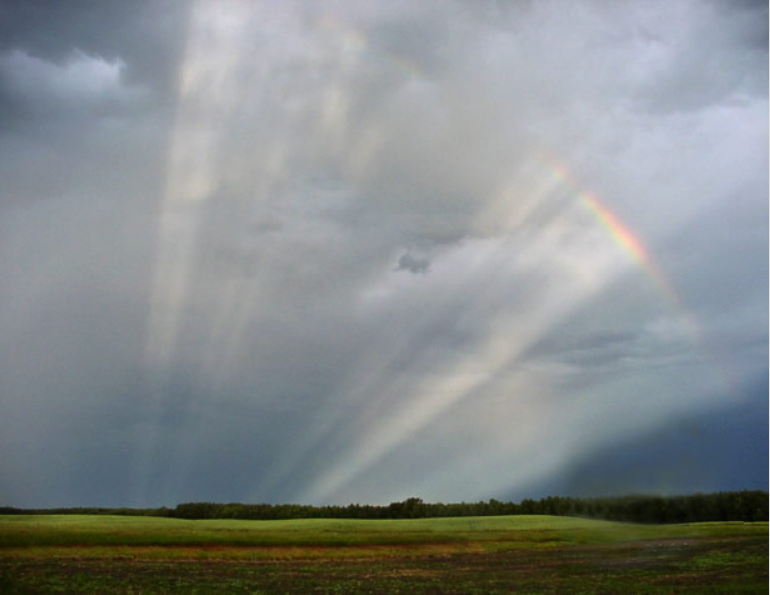Rainbow Spokes and Wheels
Rainbow Spokes and Wheels: Unveiling the Mysteries of Atmospheric Optics
Rainbows have long captivated our imaginations with their vibrant colors and ethereal beauty. But did you know that sometimes rainbows can exhibit a fascinating phenomenon known as "spokes" or "wheels"? These peculiar features add an extra touch of intrigue to an already captivating natural spectacle. In this article, we will delve deeper into the world of atmospheric optics and uncover the secrets behind these mesmerizing rainbow spokes and wheels.
When shadows in the sky converge towards the antisolar point, which coincides with the center of rainbows, perspective effects come into play. Under certain conditions, such as when clouds or dense rain showers obstruct the light entering the rainbow cone, the shadowed raindrops are unable to redirect the rainbow's rays towards our eyes. The result? Dark radial spokes emanating from the antisolar point, creating a striking resemblance to a wagon wheel. These spokes differ from their bright counterparts, known as anticrepuscular rays, as they are formed by large raindrops directing light in specific directions rather than being widely scattered by dust and aerosols.
The rotation of the rainbow wheel is another intriguing aspect that can occur when fast-moving clouds traverse the sky. As the clouds glide across the celestial canvas, the rainbow wheel seems to come alive, adding a dynamic element to its already enchanting display. This phenomenon further enhances the ephemeral nature of rainbows and reminds us of the ever-changing beauty of our atmosphere.
The brightness of the unshadowed areas within the rainbow provides valuable insights into the distribution of light within its rim. These illuminated regions vividly demonstrate the significant amount of light cast inside the rainbow's rim at deviations larger than the minimum angle required for a rainbow to form. It is within these unshadowed areas that the full spectrum of colors comes to life, captivating our senses and igniting our curiosity.
While we unravel the mysteries of rainbow spokes and wheels, it is important to note that the appearance and characteristics of these phenomena can vary depending on several factors. Factors such as the size and shape of raindrops, the angle of sunlight, and the presence of other atmospheric particles all contribute to the unique display of spokes and wheels within rainbows. The interplay between these elements creates a symphony of light and shadow, resulting in the awe-inspiring spectacle that has fascinated humans for centuries.
To fully appreciate the intricacies of rainbow spokes and wheels, it is crucial to understand the underlying principles of atmospheric optics. By studying the behavior of light as it interacts with water droplets suspended in the atmosphere, scientists have been able to unravel the secrets behind these mesmerizing phenomena. Through advanced simulations and meticulous observations, researchers continue to deepen our understanding of the complex interplay between light, water, and the atmosphere.
In conclusion, rainbow spokes and wheels offer a captivating glimpse into the wondrous world of atmospheric optics. These intriguing features, formed by shadowed raindrops and perspective effects, enhance the allure of rainbows, transforming them into dynamic and ever-changing celestial displays. As we marvel at the beauty of these phenomena, let us not forget the scientific endeavors that have unraveled their mysteries, reminding us once again of the profound connections between nature, science, and our unending quest for knowledge.

Saskatchewan rainbow spokes. Larry Phillips pictured this unusual rainbow during a storm late on July 17, 2003. ©2003 Larry Phillips, shown with permission. More spokes.
Shadows in the sky appear by perspective effects to converge towards the antisolar point, which is also the centre of rainbows. When clouds or dense rain showers shadow the light falling into your rainbow cone the shadowed raindrops can no longer send the rainbow's rays towards your eye. The result is one or more dark radial spokes centered on the antisolar point and making the rainbow sometimes resemble a wagon wheel. Bright spokes are similar to anticrepuscular rays except that light is directed into specific directions by large raindrops rather than widely scattered by dust and aerosols.
Sometimes, when clouds are moving fast across the sky, the rainbow wheel appears to rotate.
The brightness of the unshadowed areas illustrate nicely just how much of a rainbow's light is cast inside its rim at deviations larger than the minimum of the rainbow angle.
Note: this article has been automatically converted from the old site and may not appear as intended. You can find the original article here.
Reference Atmospheric Optics
If you use any of the definitions, information, or data presented on Atmospheric Optics, please copy the link or reference below to properly credit us as the reference source. Thank you!
-
<a href="https://atoptics.co.uk/blog/rainbow-spokes-and-wheels/">Rainbow Spokes and Wheels</a>
-
"Rainbow Spokes and Wheels". Atmospheric Optics. Accessed on April 27, 2024. https://atoptics.co.uk/blog/rainbow-spokes-and-wheels/.
-
"Rainbow Spokes and Wheels". Atmospheric Optics, https://atoptics.co.uk/blog/rainbow-spokes-and-wheels/. Accessed 27 April, 2024
-
Rainbow Spokes and Wheels. Atmospheric Optics. Retrieved from https://atoptics.co.uk/blog/rainbow-spokes-and-wheels/.